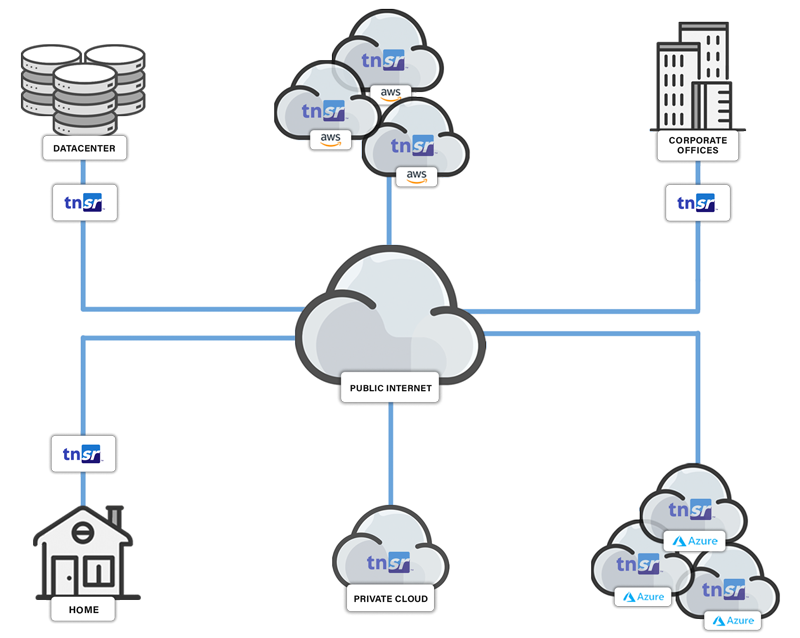It’s All in the Applications
TNSR provides stellar packet per second and gigabit per second performance for the most demanding secure networking applications.

What is High-Performance Edge and Core Routing?
The need for router speeds will only increase. But fixed-configuration, proprietary, hardware-centric edge networking solutions are a thing of the past. The modern world will be connected with high-performance network function virtualized (NFV) software routers at the edge and in the core. TNSR software provides 5, 10, 40, even 100 Gbps, or more routing via "ASIC-speed" software on commercial-off-the-shelf (COTS) hardware.

Bridging
Static Routing
Dynamic Routing
BGP
OSPF
ECMP
Static ARP
BFD
VRF-Lite
Access Control Lists
Network Address Translation
Carrier-Grade NAT
DHCP Client / Server
DNS Resolver
GRE
High-Performance Routing Features
Bridging
Bridging connects two networks so that they act as if they are one network. This is commonly used to connect interfaces across different types of links, e.g., Ethernet to VXLAN, or to enable filtering between two segments of the same network.
More information can be found in our documentation.
Static Routing
Static routing relies upon a manually-configured routing entry rather than information from a dynamic routing protocol. Static routing and dynamic routing are not mutually exclusive.
More information can be found in our documentation.
Dynamic Routing
Dynamic routing enables routers to select paths based upon real-time logical network layout changes. Popular dynamic routing protocols include Border Gateway protocol (BGP), Open Shortest Path First (OSPF), and Routing Information Protocol (RIP).
More information can be found in our documentation.
BGP
Border Gateway Protocol (BGP), the routing protocol used by the global internet, finds the best route path by weighing the latest network conditions based on reachability and routing information.
More information can be found in our documentation.
OSPF
Open Shortest Path First (OSPF) is an interior gateway protocol that uses a link state routing algorithm to find the best path between a source and destination router. TNSR supports both OSPF v2 (OSPF) and OSPF v3 (OSPF6).
More information can be found in our documentation.
ECMP
Equal-cost multi-path (ECMP) is a dynamic routing technique where packet forwarding to a single destination can occur over multiple best paths with equal routing priority.
More information can be found in our documentation.
Static ARP
Static Address Resolution Protocol (Static ARP) can be used to manually map an IPv4 network address to a MAC address that will not be removed after a period of non-use.
More information can be found in our documentation.
BFD
Bidirectional Forwarding Detection (BFD) is a protocol that can detect link failures within milliseconds, or even microseconds.
More information can be found in our documentation.
VRF-Lite
Virtual Routing and Forwarding (VRF) is a feature which uses isolated L3 domains with alternate routing tables for specific interfaces and dynamic routing purposes.
More information can be found in our documentation.
Access Control Lists
Access Control Lists (ACLs) are a collection of permit and deny rules that provide security by blocking unauthorized users and allowing authorized users to access specific resources. TNSR software supports L2 MACIP ACLs, L3 ACLs (IPv4 and v6), L4 ACLs, and Host ACLs.
More information can be found in our documentation.
Network Address Translation
Network address translation (NAT) is a method of mapping an IP address space into another by modifying network address information in the IP header of packets while they are in transit across a traffic routing device.
TNSR supports the following NAT functionality:
- Port Forwards - allows external devices access to computers on private networks by mapping an external port to an internal IP address and port
- 1:1 NAT - maps a single external IPv4 address (usually public) to a single internal IPv4 address (usually private)
- Outbound NAT - (sometimes referred to as Source NAT, Overload NAT or Port Address Translation (PAT)) changes the source address and port of packets exiting a given interface in order to 1) hide the origin of a packet, or 2) allow multiple IPv4 hosts inside a network to share one, or a limited number of, external or outside addresses on a router
- Network Prefix Translation (NPt) works similarly to 1:1 NAT but operates on IPv6 prefixes instead
More information can be found in our documentation.
Carrier-Grade NAT
Service providers around the world face a problem of IPv4 address space exhaustion. This is, of course, driving not only IPv6, but the use of address space mapping technologies that help extend the life of compute and networking equipment that are bound to IPv4 address usage.
Carrier-grade NAT (CGN or CGNAT), also known as large-scale NAT (LSN), is an approach to IPv4 network design where end sites, particularly residential networks, are configured with private network addresses that are translated to public IPv4 addresses by network address translator solutions located within the service provider’s network, permitting the sharing of small pools of public addresses among many end sites. This shifts the NAT function from the end customer network to the service provider network.
TNSR supports two technologies useful to CGNAT:
- NAT44 - maps each application flow on the customer side to the public IPv4 address and one of its TCP or UDP ports as identified by the combination of a private IPv4 address and a TCP or UDP port Mapping of Address and Port
- (MAP) - MAP is a carrier-grade IPv6 transition mechanism capable of efficiently transporting high volumes of line-rate IPv4 traffic across IPv6 networks. TNSR supports both MAP-T (which uses translation) and MAP-E (which uses encapsulation). TNSR can currently act as a Border Relay (BR) providing service to Customer Edge (CE) clients.
- Network Address Translation-Traversal (NAT-T) - the standards-based approach for IPsec encapsulation in User Datagram Protocol (UDP) to ensure that data protected by IPsec can pass through NAT without discarding packets - key for IPsec VPN connections that traverse connections where NAT is present, especially for service providers
More information can be found in our documentation.
DHCP Client / Server
A Dynamic Host Configuration Protocol (DHCP) Server is a network server that automatically provides and assigns IP addresses, default gateways and other network parameters to client devices. TNSR can be configured as a client and server.
More information can be found in our documentation.
DNS Resolver
A Domain Name Server (DNS) resolver receives and resolves DNS (URL to IP address) queries from web browsers and other applications.
More information can be found in our documentation.
GRE
Generic Routing Encapsulation (GRE) wraps (encapsulates) one data packet within another - to create a direct point-to-point connection across a network - to simplify connections between separate networks.
More information can be found in our documentation.
Who Needs High Performance Routing?

Businesses, Educational Institutions and Government Agencies
Any business, educational institution, or government agency must have edge network infrastructure that supports LAN and WAN device connection speeds that are rapidly moving from 100-300 Mbps to 1 Gbps, 2.5 Gbps, 10 Gbps, even 40 Gbps or higher. This in turn is driving campus network designs of 100 Gbps or more, and premise to Internet / cloud connections of 10 Gbps or more. But at today’s conventional technology prices, scaling edge networking to this level is cost-prohibitive.

Service Providers
Service providers must not only be able to address customer requests for cost-effective 1, 2.5, 5, 10, 40 Gbps or higher WAN connections, but routing infrastructure must be able to dynamically scale up and down in seconds to meet the ever increasing demands of digital transformation.
Where Should High-Performance Routers Be Deployed?
High-performance routers will be needed at the network edge, in network cores, from premise-to-cloud direct connect infrastructure (where available) and even between public or private Virtual Private Clouds (VPCs).

What Makes TNSR a Great High-Performance Router Solution?
High Throughput
- Leverages Vector Packet Processing (VPP) to improve packet processing performance one to two orders of magnitude over kernel-based processing solutions
- Performance scales as connection bandwidth increases, and as packet sizes fall from jumbo frames to IMIX to pure 64 byte traffic - driven by the most demanding applications
Feature Rich
- Bridging, Static Routing, Dynamic Routing, BGP, OSPF, ECMP, BFD, VRF and more
- Integrates VPP, DPDK, FRR, strongSwan, Clixon, RESTCONF open source technologies and more into a turnkey, ready to use commercial product
Easily Scalable
- Scale out with appliances, virtual machines or cloud instances
- Scale up by increasing bandwidth per instance to the limit of hardware capabilities, no license constraints
- Leverage crypto offload for additional performance scale up
Excellent overall solution value
- Unbeatable packet processing price-performance for any router application
- No feature, bandwidth or other incremental licensing charges
- Leverages the most advanced open source technologies
- Commercial subscriptions include the full benefit of seasoned global support specialists

%201.png?width=302&name=Netgate%20Logo%20PMS%20(horizontal)%201.png)
